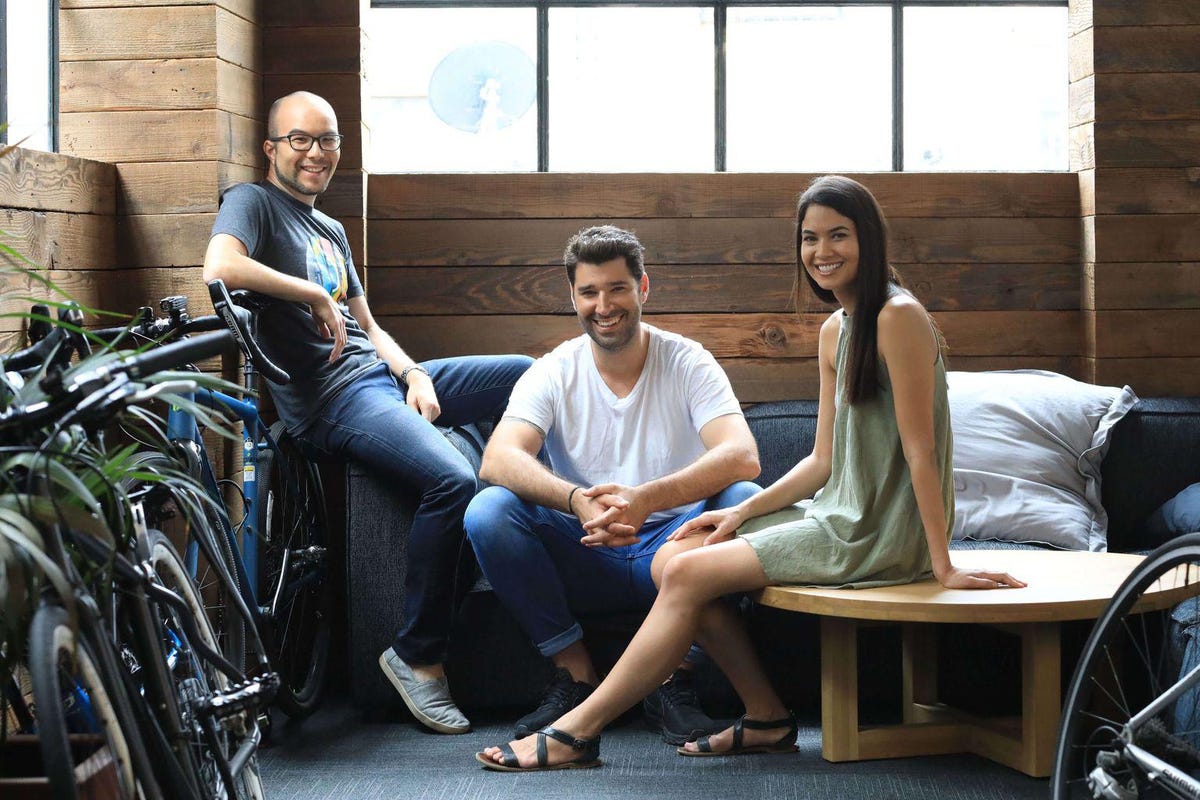
Canva founders Cameron Adams (left), Cliff Obrecht (center) and CEO Melanie Perkins (right) now lead one of the world’s most valuable startups from Australia.
Canva
Canva is now one of the world’s most valuable startups after raising $200 million in new funding at a $40 billion valuation.
The round, led by T. Rowe Price with Franklin Templeton, Sequoia, Bessemer Venture Partners, Greenoaks Capital, Dragoneer, Blackbird, Felicis and AirTree all participating, more than doubles the Australian design software company’s valuation in five months.
Canva’s already on a level few startups have reached — not just for a valuation second only to Stripe on the Forbes Cloud 100 list of top private cloud companies. Long profitable and cash-flow positive, Canva continues to more than double in sales, the company says, on pace to reach a $1 billion annualized revenue run-rate by December 2021, the “vast majority” of that recurring subscription revenue. “Moving in the right direction,” cofounder and CEO Melanie Perkins says matter-of-factly.
Profitable, doubling growth and with hundreds of millions of revenue — why bother raising at all? One reason, says Perkins, is to keep doubling headcount, which reached 2,000 this year (Perkins says Canva received 180,000 job applications over the past 12 months). Another could be acquisitions, sources close to Canva add. Then there’s Perkins’ own lifelong mission for Canva, one for which she thinks it’s worth it to play it safe.
“It’s a huge vote of confidence in what we’re doing and where we’re going,” Perkins tells Forbes. “I always like to have enough money in the bank that if the lights turned off tomorrow and everything disappeared, we’ve got enough capital to keep us together for a long time.”
Melanie Perkins on the cover of Forbes in 2019.
DEAN MACKENZIE/IDC FOR FORBES Alex Konrad
With unusual origins in Perth, Australia, and then Sydney, where the company has long been based, Canva defied early skepticism to emerge as one of the world’s most popular and fastest-growing software tools, putting Perkins, a Forbes 30 Under 30 alum, on the cover of the magazine in December 2019. Started in 2012 by Perkins, now-husband Cliff Obrecht and Cameron Adams, Canva launched the following year as a tool to help anyone design, from better-looking resumes to menus, business cards and other graphic assets.
Today, Canva’s product has evolved to support video, presentations and most recently, live collaboration. With new websites tools, Perkins says she hopes to help do away with PDF resumes or event invites in favor of responsive sites complete with custom web domains (a product that will pitch Canva, already competitive with Adobe and Vistaprint, up against the likes of Squarespace and Wix). Canva’s library now consists of more than 800,000 templates and 100 million photos, illustrations and fonts. More than 7 billion designs have been created in Canva to date, the company says, with 120 new designs each second.
Originally known as a tool for amateur designers or small businesses, Canva’s freemium software is used by more than 60 million monthly users. But more than 500,000 paying teams now use Canva, too, including companies like American Airlines, CBRE, Intel, Kimberly-Clark and Zoom, for everything from social media assets to sales and human resources presentations, or, in the case of Live Nation, assets for upcoming rock concerts.
The new funding dramatically increases the value of Canva’s founders’ stakes in the business, previously valued at $15 billion valuation in April. Forbes estimates that Perkins and Obrecht each own about 18% of Canva, and Adams 9%. At a $40 billion valuation, that means Perkins and Obrecht each hold stakes valued at $6.5 billion, while Adams’ stake is valued at $3.2 billion. (Forbes deducts 10% for private company holdings.)
But already on the record that they didn’t plan to “hoard” such wealth, Perkins and Obrecht are now pledging to give away 30% of Canva — the “vast majority” of their stakes — to the Canva Foundation to be used for charitable causes. “If the whole thing was about building wealth that would be the most uninspiring thing I could possible imagine,” Perkins tells Forbes. “It has felt strange when people refer to us as ‘billionaires’ as it has never felt like our money, we’ve always felt that we’re purely custodians of it,” she added in a blog post.
Canva first plans to pilot its charitable giving through a $10 million donation to non-profit GiveDirectly to distribute to vulnerable families in Southern Africa; it plans to ramp up its giving after that.
It’s all part of what Perkins has long described as a “two step plan” for maximum impact: “become one of the most valuable companies in the world, and do the best we can do.” On the first count, Canva’s well on its way, with no shortage of investors looking to pony up money even at a valuation more typical of a public company (Perkins says she has no current interest in an IPO). On the second, Canva joined the Pledge 1% movement in the past to donate time, money, equity and resources to charity; the startup works with 60,000 schools today and 130,000 non-profits. Canva has also committed to plant one tree for each print order it services, a tally that’s reached 2 million to date.
“As we continue to make progress on step one, step two becomes more important than ever,” says Perkins. “We really feel a huge responsibility… it shouldn’t matter where you are in the world, or socioeconomic status, or your skills and experience, everyone should have the ability to design.”







